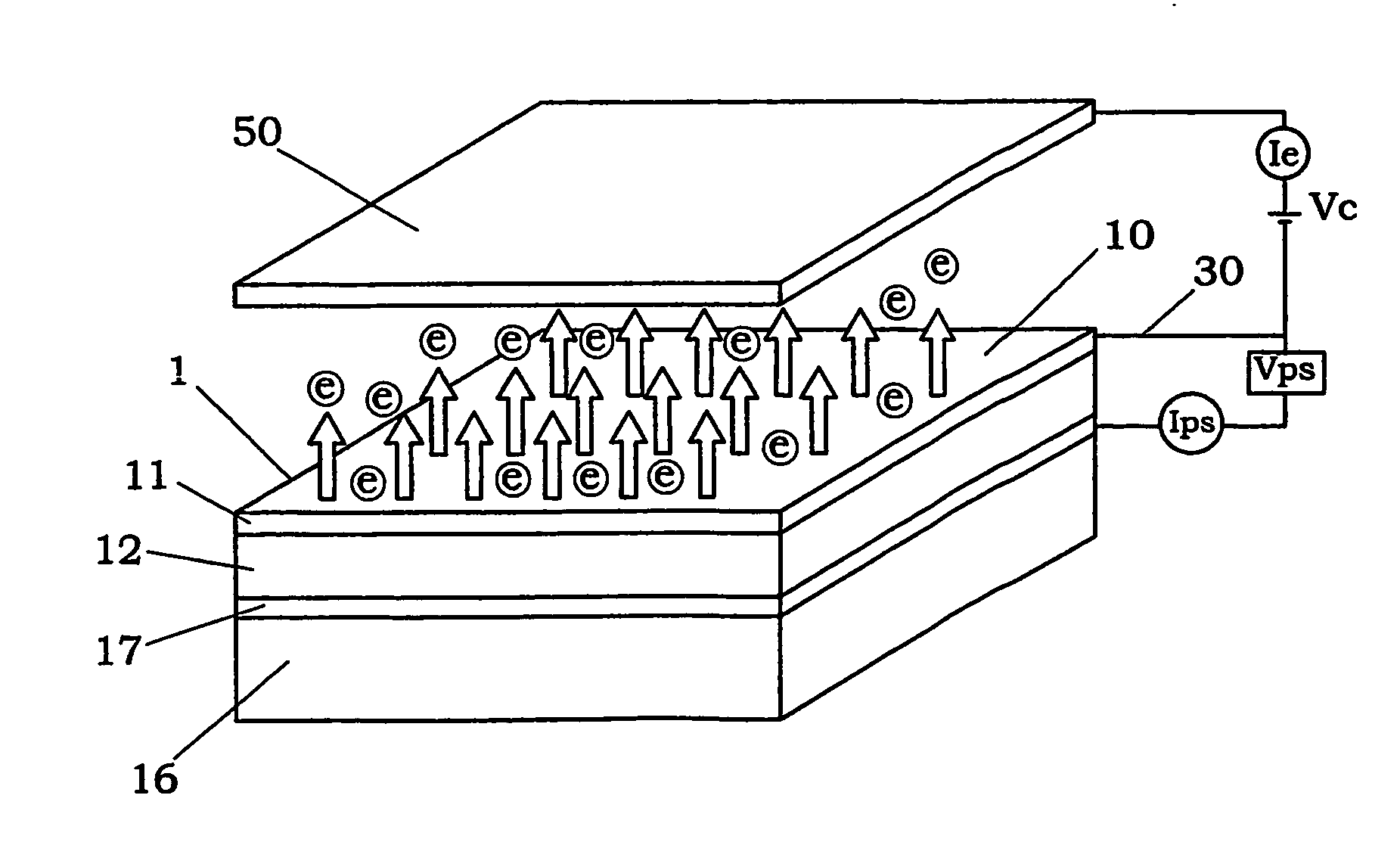Mehtod and apparatus for modifying object with electrons generated from cold cathode electron emitter
a technology of electron emitter and electron beam, which is applied in the direction of static indicating device, discharge tube main electrode, instruments, etc., can solve the problems of narrow application area of the apparatus, narrow device structure, and reduced treatment efficiency, and achieve the effect of reducing the modification cos
- Summary
- Abstract
- Description
- Claims
- Application Information
AI Technical Summary
Benefits of technology
Problems solved by technology
Method used
Image
Examples
first embodiment
[0036] As shown in FIGS. 1 and 2, an apparatus for modifying an object 2 with electrons according to the present embodiment comprises a cold cathode electron emitter 1 having a planar electron emitting portion 10, a voltage applying unit 30 for applying a voltage to the emitter to emit electrons from the planar electron emitting portion, a case 20 for accommodating the emitter therein, which is made of an insulating material and has an opening 21 used to provide the emitted electrons to the outside of the case, and a holder 40 for supporting the object 2 such that the object is exposed to the electrons provided through the opening. In FIG. 1, the numeral 50 designates a mesh electrode attached to the opening 21 to accelerate the electrons generated from the emitter 1. Alternatively, a window member made of a material, through which the electrons can pass, may be attached to the opening in place of the accelerating electrode.
[0037] As shown in FIG. 2, the cold cathode electron emitt...
second embodiment
[0061] In this embodiment, apparatus and method for modifying a gas as the object by irradiation of electrons are explained.
[0062] As shown in FIG. 10, the modifying apparatus of this embodiment is characterized by comprising a case 20 having a gas inlet 22 for supplying the object gas into the case, and an opening 21 for providing a modified gas to the outside, and an acceleration electrode (anode electrode) 50 disposed in a face-to-face manner with an electron emitting portion 10 of a cold cathode electron emitter 1 in the case. The cold cathode electron emitter is the same as the emitter used in the first embodiment. Therefore, duplicate explanation is omitted. To avoid the influence of humidity on electron emitting efficiency of the cold cathode electron emitter, it is preferred that the gas supplied in the case 20 through the gas inlet 22 is a dry gas having a low moisture content. For example, it is preferred that the relative humidity (RH %) is smaller than 30%, and more pre...
third embodiment
[0069] In this embodiment, modifying apparatus and method for irradiating electrons to a gas or a gas containing liquid particles such as steam or moisture are explained.
[0070] That is, as shown in FIG. 15, this modifying apparatus is characterized by using a case 20 comprising gas inlets 22 for supplying a gas into the case, which are formed in lower portions of side walls of the case, and an opening 21 for ejecting electrons emitted from the cold cathode electron emitter 1, which is formed in a top wall at a position facing the electron emitting portion 10 of the cold cathode electron emitter placed on a bottom wall of the case. In addition, this apparatus has an accelerating electrode SO disposed above the opening, and a gas flow channel 70 provided on the top wall of the case 20. In this case, the gas is supplied as the object to the gas flow channel 70 from a gas supply unit 72, as shown by the horizontal arrow in FIG. 15, and then modified by the electrons accelerated from th...
PUM
 Login to View More
Login to View More Abstract
Description
Claims
Application Information
 Login to View More
Login to View More - R&D
- Intellectual Property
- Life Sciences
- Materials
- Tech Scout
- Unparalleled Data Quality
- Higher Quality Content
- 60% Fewer Hallucinations
Browse by: Latest US Patents, China's latest patents, Technical Efficacy Thesaurus, Application Domain, Technology Topic, Popular Technical Reports.
© 2025 PatSnap. All rights reserved.Legal|Privacy policy|Modern Slavery Act Transparency Statement|Sitemap|About US| Contact US: help@patsnap.com



